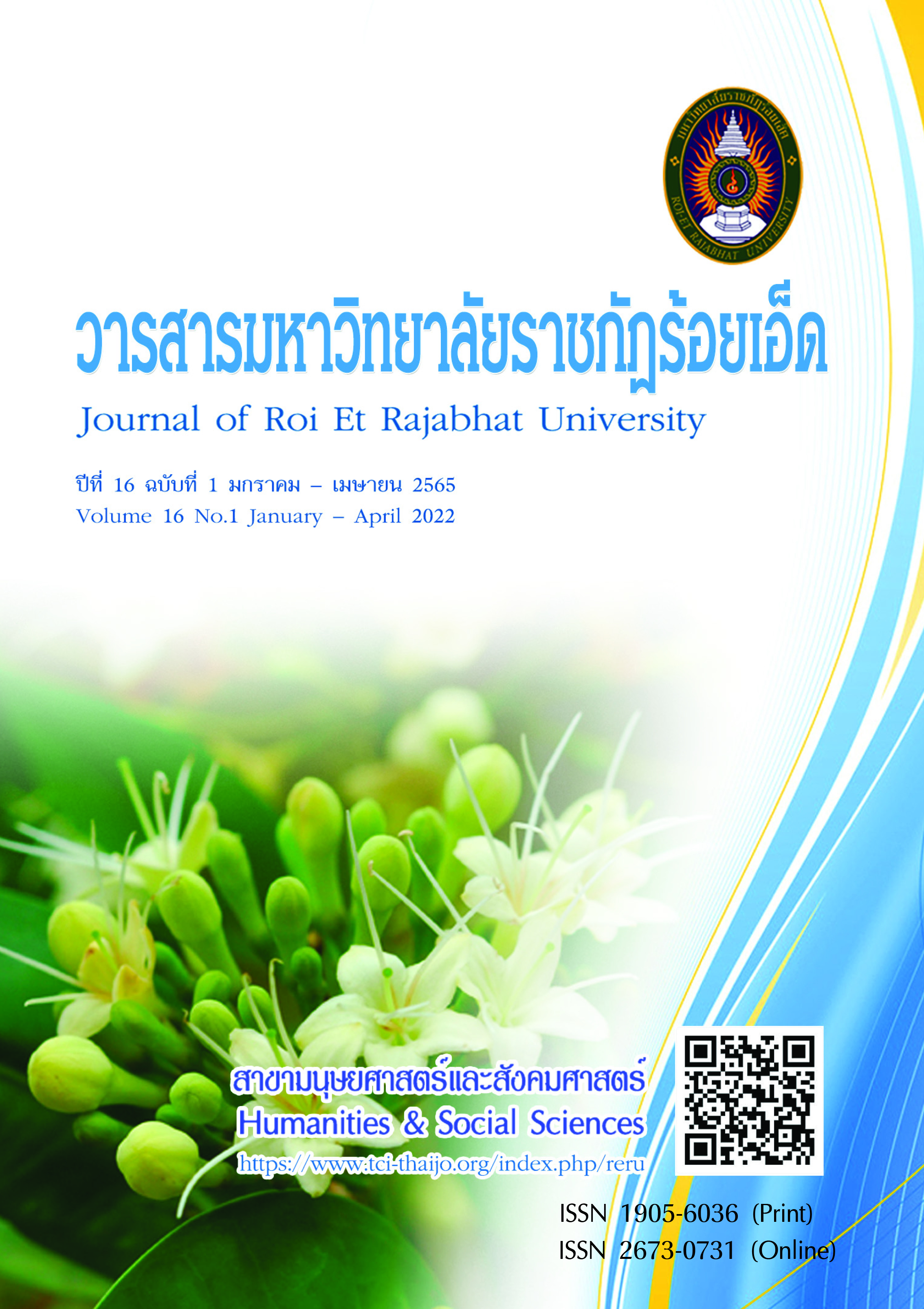The Development of English Vocabulary Learning Activities using Language Teaching, Activities for Communication Cooperated with Songs for Grade 1 Students
Keywords:
Language teaching activities for communication cooperated with songs, English vocabulary learning, Ability of English vocabulary learningAbstract
The purposes of this research were to: 1) develop the language teaching activities for communication cooperated with songs of Prathomsuksa 1 students with the efficiency criteria of 75/75, 2) compare the ability of English vocabulary learning of Prathomsuksa 1 students before and after using language teaching activities
for communication together with songs, and 3) study the satisfaction of Prathomsuksa 1 students towards the organization of language teaching activities for communication by using songs. The subjects of the study were 39 Prathomsuksa 1/3 students in the second semester of academic year 2019 at Anubankittiya School, all of them were selected by using cluster random sampling. The research instruments in this study were: 1) six English learning management lesson plans using language teaching activities for communicate together with songs for Prathomsuksa 1 students, 2) English vocabulary learning ability test is a multiple-choice test of 3 choices with 20 items, and 3) a 9-item Questionnaire of Prathomsuksa 1 students’ satisfaction towards English vocabulary learning languages teaching activities for communication cooperated with songs.
The data was analyzed by using SPSS statistical package, means, standard deviation, percentage and t-test (dependent samples).
The results of research were as follows: 1) results of language teaching activities for communication cooperated with songs for Prathomsuksa 1 students had the efficiency (E1/E2) of 79.01 / 78.46, which showed higher efficiency than the 75/75 criteria, 2) Prathomsuksa 1 students who learned by using language teaching activities for communication together with songs had the higher ability to learn English vocabulary after the experiment than before the experiment with statistical significance at the level of .05 and 3) students were satisfied towards the English vocabulary activities learning using language teaching activities for communication cooperated with songs of Prathomsuksa 1 students. The overall satisfaction level was at a high level
( = 2.50, S.D. = 0.37).
References
กรมวิชาการ. (2551). หลักสูตรแกนกลางการศึกษาขั้นพื้นฐาน พุทธศักราช 2551. กรุงเทพฯ: โรงพิมพ์องค์การรับส่งสินค้าและพัสดุภัณฑ์.
กรมวิชาการ. (2540). แนวทางการสอนที่เน้นทักษะกระบวนการ. กรุงเทพฯ: โรงพิมพ์คุรุสภา ลาดพร้าว.
กระทรวงศึกษาธิการ. (2551). หลักสูตรแกนกลางการศึกษาขั้นพื้นฐาน พุทธศักราช 2551. กรุงเทพฯ: โรงพิมพ์การศาสนา.
กระทรวงศึกษาธิการ. (2552). หลักสูตรแกนกลางการศึกษาขั้นพื้นฐาน พุทธศักราช 2551. กรุงเทพฯ: โรงพิมพ์ชุมนุมสหกรณ์ การเกษตรแห่งประเทศไทย จำกัด.
ธีมาพร สลุงสุข. (2555). การเปรียบเทียบความสามารถในการจำคำศัพท์และเจตคติต่อการเรียนวิชาภาษาอังกฤษของนักเรียนชั้นประถมศึกษาปีที่ 4 ที่ได้รับการสอนโดยใช้เพลงประกอบกับเกมประกอบ. วิทยานิพนธ์ ครุศาสตรมหาบัณฑิต สาขาวิชาการสอนภาษาอังกฤษ. ลพบุรี: มหาวิทยาลัยราชภัฏเทพสตรี.
ประภัสสร พึ่งอินทร์. (2552). การพัฒนาชุดการเรียนการสอนทักษะการฟัง การพูดภาษาอังกฤษโดยใช้เพลง สำหรับนักเรียนชั้นประถมศึกษาปีที่ 1 โรงเรียนชายเขาวิทยา จังหวัดอุตรดิตถ์. วิทยานิพนธ์ ครุศาสตรมหาบัณฑิต สาขาวิชาหลักสูตรและการสอน. อุตรดิตถ์: มหาวิทยาลัยราชภัฏอุตรดิตถ์.
วิโรจน์ ปะรัมย์. (2561). ผลการใช้กิจกรรมเพลงเพื่อส่งเสริมความสามารถในการฟัง-พูดภาษาอังกฤษและความรู้ด้านคำศัพท์ ของนักเรียนชั้นประถมศึกษาปีที่ 2. วิทยานิพนธ์ ครุศาสตรมหาบัณฑิต สาขาวิชาหลักสูตรและการจัดการเรียนรู้. บุรีรัมย์: มหาวิทยาลัยราชภัฏบุรีรีมย์.
ศุภวัลย์ ชูมี. (2557). ผลการใช้เพลงประกอบการสอนเพื่อพัฒนาความสามารถในการเรียนรู้คำศัพท์ภาษาอังกฤษ
และความคงทนในการจำคำศัพท์ภาษาอังกฤษ ของนักเรียนชั้นประถมศึกษาปีที่ 5 โรงเรียนบ้านกาแบง จังหวัดสตูล. วิทยานิพนธ์ ศึกษาศาสตรมหาบัณฑิต สาขาวิชาศึกษาศาสตร์. นนทบุรี: มหาวิทยาลัยสุโขทัยธรรมาธิราช.
ศิริวรรณ โสภิตภักดีพงษ์. (2544). การใช้เกมประกอบการสอนเพื่อสร้างความคงทนในการเรียนรู้คำศัพท์ ของนักเรียนชั้นประถมศึกษาปีที่ 6. สารนิพนธ์ ศึกษาศาสตรมหาบัณฑิต สาขาวิชาการสอนภาษาอังกฤษในฐานะ
ภาษาต่างประเทศ. กรุงเทพฯ: มหาวิทยาลัยศรีนครินทรวิโรฒประสานมิตร.
Bonnel, A., Faita, F., Peretz, I. and Besson, M. (2001). Divided attention between lyrics and tunes of operatic songs: evidence for independent processing. Perception and Psychophysics, 63(7), 1201-1213.
Crystal, D. (1997). English as a global language. Cambridge: Cambridge University Press.
DeAndres, V. (2002). The influence of affective variable on EFL/ESL learning and teaching. The journal of Imagination in Language Learning and Teaching, 7(3), 92-97.
Kathleen, B.E. (1999). Speaking: a critical skill and a challenge. CALICO, 16(3), 277.
Khamkhien, A. (2011). Teaching English Speaking and English Speaking Tests in the Thai Context: A Reflection from Thai Perspective. English Language Teaching, 3(1), 185-189.
Krashen, S.D. and Terrell, D.T., (1988). The natural approach: language acquisition in classroom.
Great Britain: Pergamon Alemany Press.
Lake, R. (2002). Enhancing acquisition through music. The journal of Imagination in Language Learning and Teaching, 7(3), 98-107.
Larsen-Freeman, D. (2000). Techniques and Principles in Language Teaching (2nd ed.). Oxford: OUP.
Li, X. and Brand, M. (2009). Effectiveness of music on vocabulary acquisition, language usage and meaning for mainland Chinese ESL learners. Music education, 36(1), 73-84.
McCarthy, B. (1997). A tale of four learner: 4 MAT learning styles. Eric Accession : NISC Discover Report, 46-51.
Moon, J. (2005). Children learning English. Oxford: MacmilianPublishers.
Murphy, T. (1990). The song stuck in my head phenomenon: a melodic din in the LAD?. System, 18(1), 53-64.
Nation, I.S.P. (2008). Teaching and Learning Vocabulary. New York: Newbury House Publishers.
Wallerstein, Harvey. (1971). Dictionary of Psychology : Maryland : Penguin Book Ine.
Weikart, P. (1998). Teaching movement and dance: a sequential approach to rhythmic movement. Ypsilanti. MI: High/Scope Press.
Downloads
Published
How to Cite
Issue
Section
License
Copyright (c) 2022 Roi Et Rajabhat University

This work is licensed under a Creative Commons Attribution-NonCommercial-NoDerivatives 4.0 International License.
บทความที่ได้รับการตีพิมพ์เป็นลิขสิทธิ์ของวารสารมหาวิทยาลัยราชภัฎร้อยเอ็ด
ข้อความที่ปรากฏในบทความแต่ละเรื่องในวารสารวิชาการเล่มนี้เป็นความคิดเห็นส่วนตัวของผู้เขียนแต่ละท่านไม่เกี่ยวข้องกับมหาวิทยาลัยราชภัฎร้อยเอ็ด และคณาจารย์ท่านอื่นๆในมหาวิทยาลัยฯ แต่อย่างใด ความรับผิดชอบองค์ประกอบทั้งหมดของบทความแต่ละเรื่องเป็นของผู้เขียนแต่ละท่าน หากมีความผิดพลาดใดๆ ผู้เขียนแต่ละท่านจะรับผิดชอบบทความของตนเองแต่ผู้เดียว





